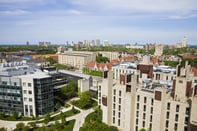Published on
On Campus or Off Campus: Where Should Continuing Education be Physically Located?

Location matters—at least that’s the adage in real estate.
What about continuing education? Does the location of classrooms and administrative offices, relative to the rest of the campus, make a difference in continuing education enrollments?
Over the years I’ve visited about 120 college campuses, and seen CE operations in a variety of locations. The most common location I’ve seen for CE has been on the edge of campus in a repurposed building. University of Nevada Las Vegas, for example, has their continuing education unit inside an old elementary school just south of campus. There is plenty of free parking, extensive classroom space, and it is located on a busy corner just minutes from “The Strip.” Their building has been repurposed from a school to academic offices and classrooms, and despite the busy location and other drawbacks, they have done an admirable job with refreshing HVAC, telecommunications, and other vital infrastructure. It’s not an ideal setup, but they’ve done well adapting to what they have.
Northern Arizona University’s Computer Training Center, on the other hand, is housed on the first floor, right off the main entrance of the College of Business building. The building is new and has won awards for its eco-friendly practices. Undergraduate students, graduate students, and faculty alike walk by and congregate near the CE program’s signs and entrance. Exposure for the unit is high. However, there is limited parking—all paid-permit or meter-based—and classroom space in the building can be hectic to find at peak academic times.
There are other schools, none of which I wish to name, that have located their CE operations off campus—sometimes miles from campus and without transportation options other than private automobile. This allows the CE unit great leeway when it comes to managing space, dealing with walk-in visitors and the like. However, for current and prospective students, it puts visibility and accessibility at a possible disadvantage.
So, what is the best option for CE leaders to take—if they are able to claim their own location?
I think the best option is what we see most commonly: choosing a location on the edge of campus. It allows traditional students access to the CE administrative areas, while still allowing off-campus visitors to more easily locate the facility. A custom-built facility designed from the ground up would be ideal, but being on campus provides students, faculty, and administrators a sense of belonging, while still providing the unit with the flexibility required to meet the diverse needs of the continuing education community.
Author Perspective: Administrator



